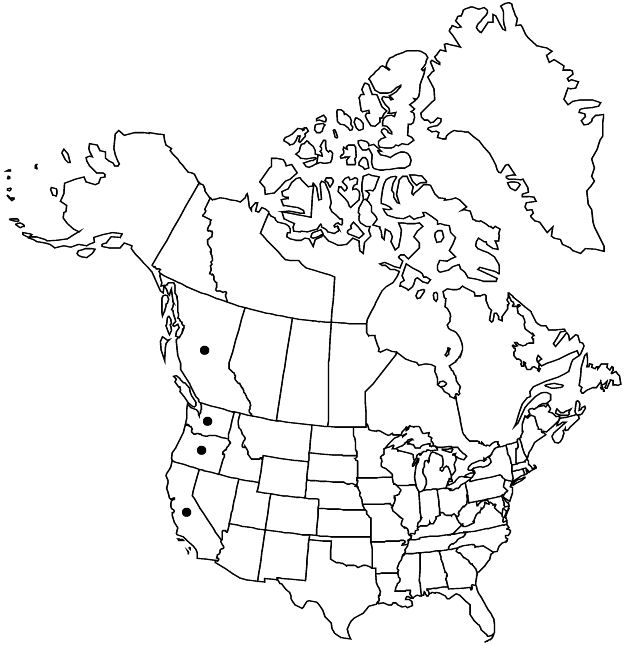Rosa pisocarpa
Proc. Amer. Acad. Arts 8: 382. 1872.
Shrubs, loosely clustered or in dense thickets. Stems ascending to erect, (2–) 4–20 (–25) dm, openly branched; bark ± glaucous when young, dark reddish-brown or dull red with age outer layer may exfoliate as thin ash gray peel, glabrous; infrastipular prickles usually paired, erect, rarely curved, usually subulate, 2–10 × 2–4 mm, base glabrous, internodal prickles rare or absent. Leaves 5–10 (–13) cm; stipules 8–22 × 2–5 mm, auricles flared, 2–5 mm, margins usually entire, sometimes erose or lobed, finely ciliolate to ciliate, eglandular, surfaces glabrous or sparsely pubescent, sparsely stipitate-glandular or eglandular; petiole and rachis sometimes with pricklets, glabrous or hairy hairs to 1 mm, sometimes stipitate-glandular; leaflets 5–7 (–9), terminal: petiolule 8–12 mm, blade elliptic-ovate, (15–) 20–45 (–60) × 9–16 (–20) mm, widest at or below middle, membranous, base cuneate to obtuse, margins 1 (–2) -serrate, teeth 12–22 per side, on distal 3/4–4/5 of margin, acute, eglandular, apex acute, sometimes obtuse, abaxial surfaces pale green, usually sparsely pubescent, eglandular, adaxial green, dull, glabrous, rarely puberulent. Inflorescences corymbs, sometimes panicles or solitary flowers, 1–12-flowered. Pedicels erect, sometimes recurved, slender, 10–22 mm, usually glabrous, sometimes finely puberulent, eglandular, rarely stipulate-glandular; bracts 2–3, lanceolate, 8–14 × 3–6 mm, margins entire, sometimes serrate, irregularly stipitate-glandular and/or erose, surfaces glabrous or pubescent, eglandular. Flowers 2.4–3.8 cm diam.; hypanthium ovoid-urceolate, 3–5 × 2.5–3.5 mm, glabrous, rarely setose, eglandular, neck (0–) 0.5–1 × 2 mm; sepals spreading, ovatelanceolate, 10–17 × 1.5–3 mm, tip 3–7 (–10) × 1.5–2.5 mm, margins entire, abaxial surfaces sometimes puberulent, densely or sparsely stipitate-glandular, rarely eglandular; petals single, pink to deep pink, 12–18 × 10–18 mm; stamens 75; carpels 22–35, styles exsert 1–2 mm beyond stylar orifice (1 mm diam.) of hypanthial disc (3.5 mm diam.). Hips scarlet, globose, sometimes subglobose or ovoid, 7–15 × 7–13 mm, fleshy, glabrous, eglandular, rarely setose or stipitate-glandular, neck (0–) 1–1.5 × 1.5–3.5 mm; sepals persistent, erect. Achenes basiparietal, 5–35, tan, 3–4 × 1.5–2.5 mm. 2n = 14, 28.
Distribution

B.C., Calif., Oreg., Wash.
Discussion
Subspecies 2 (2 in the flora).
Selected References
None.
Key
| 1 | Inflorescences (1–)3–12-flowered; sepal abaxial surfaces usually stipitate-glandular, tips to 10 mm; infrastipular prickles (1–)2; hips usually globose, rarely subglobose, abruptly narrowed to necks 1.5–3 mm diam.; leaflets most commonly 7, terminal blade 15–35 mm. | Rosa pisocarpa subsp. pisocarpa |
| 1 | Inflorescences 1–3(–10+)-flowered; sepal abaxial surfaces usually eglandular, rarely stipitate-glandular, tips to 7 mm; infrastipular prickles 0–1(–2); hips subglobose to ovoid, gradually to abruptly narrowed to necks 2.5–3.5 mm diam.; leaflets most commonly 5, terminal blade 20–45(–60) mm. | Rosa pisocarpa subsp. ahartii |
"widest" is not a number."dm" is not declared as a valid unit of measurement for this property."dm" is not declared as a valid unit of measurement for this property."dm" is not declared as a valid unit of measurement for this property.